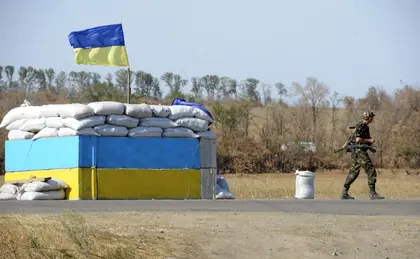After driving 10 kilometers, the fleeing Ukrainians were instead trapped under massive shelling by cannons and tanks. The armored vehicles caught fire.
“That was a real meat grinder,” Taras Samchuk, 28, soldier of 51th brigade told the Kyiv Post. “One armored vehicle exploded right next to us and the head of its gunner was burning in its helmet.”
JOIN US ON TELEGRAM
Follow our coverage of the war on the @Kyivpost_official.
The Ukrainian troops lost hundreds of their fighters, including at least 100 killed, with others wounded or captured on the way out of Ilovaisk, a strategic city through which separatists were receiving military supplies from Russia to the besieged provincial capital of Donetsk.
- Obtain the freshest war in ukraine update from the Kyiv Post's daily news coverage today.
- Find the latest Ukraine news published as of today.
Those who survived the Ilovaisk tragedy directly place the blame on the Russian army, whose soldiers did most of the fighting. They also blame Ukraine’s military commanders for sending soldiers and volunteer fighters into war without sufficient reconnaissance or reinforcements.
The whole Iloviask tragedy exposed many problems in this war, from the involvement of the Russian army to the lack of trust and coordination between the volunteer battalions and the army.
While most of Ukraine’s volunteer battalions were formed as special police units that should support the army, in Ilovaisk they became the main combat force.

Fighters of the Donbas, Dnipro, Azov and Shakhtarsk volunteer battalions initially took Ilovaisk on Aug. 19. But the town turned out to be a trap for them.
Vadim, 34, a deputy commander of Azov Battalion who is known under his nom-de-guerre Trojan, said the battalion’s scouts reported strong fortifications and heavy weapons in possession of the Kremlin-backed insurgents around Ilovaisk, as well as Zuhres, Khartsyzsk and Mospine. But the army generals did not trust these reports and sent men into battle without proper reconnaissance.
But Ukraine’s commanders underestimated the enemy. On Aug. 19-20, the Ukrainian fighters in Ilovaisk were repeatedly shelled by Grad multiple rocket launchers and the well-trained pro-Russian Vostok and Oplot battalions.
On Aug. 19, Azov’s battalion members were massively shelled across the Russian border. “It looked like a sunrise, but in fact it was the Smerch rockets shelling us,” Vadim, a former crisis manager in Kyiv, said.
Since early Aug. 24, when the rest of the country celebrated Independence Day, the Ukrainian soldiers also started seeing Russian regular army and military vehicles on Ukraine’s territory. They were no longer hiding.
Samchuk, who used to be a bartender in Lutsk before joining the army, said his 51th brigade burned a column of armored vehicles with distinctive Russian white emblems painted on them. A dozen Russian paratroopers were captured by the same brigade on the next day.
On Aug 24, Russian forces managed to surround Ukrainians in Ilovaisk, killing dozens of soldiers with heavy rocket shelling. The situation continued to aggravate for the next two days, and no reinforcements were coming. Many men, including the commander of the Kherson Battalion, were killed.
Semen Semenchenko, commander of the Donbas Battalion, who had been wounded in fights and was being treated in Dnipropetrovsk, demanded reinforcements to Ilovaisk from the Ukrainian government. Hundreds of Ukrainians picketed the army demanding help to get the fighters out of the trap and save their lives.
Early in the morning on Aug. 29, Russian President Vladimir Putin called for a “humanitarian corridor for besieged Ukrainian soldiers in order to avoid senseless victims,” the Kremlin said. But either the Russian troops disobeyed their leader, were never ordered to open such a corridor in the first place, and Ukrainians who tried to use the corridor, were destroyed.
Samchuk said apart from his 51th brigade, there were also fighters of Donbas and Dnipro battalions and soldiers of the 92th brigade from Kharkiv who tried to use the corridor. The soldier said he managed to survive thanks to the driver, who directed their armored vehicle across the forest into the corn fields, saving 15 lives.
Most of the soldiers who managed to get out of that hellish trap had wounds of every description, including broken legs, teeth, noses and shrapnel in their bodies. Samchuk, who took a part of a shell out of his shoulder himself and had bruises all over his head, didn’t consider these injuries at all.
Residents of Komsomolske, a town south of Ilovaisk, said they saw a column of exhausted Ukrainian soldiers heading from there in the morning on Aug. 30. “They were dirty, unshaved, some wounded, some with their pants torn,” a local resident told the Kyiv Post, fearing to give his name.
Russian TV channel Rossiya showed footage with dozens of Ukrainian servicemen, wounded and humiliated, in captivity of separatists. A bearded rebel commander called Senia said that he has 173 Ukrainians captured near Ilovaisk. He said the rebels wanted to make them rebuild the destroyed cities of Donbas.
The battalion commanders as well as army soldiers are blaming army generals for the tragic events in Ilovaisk, as well as leaks about the location of Ukrainian forces. All of them feel betrayed by Ukraine.
“I don’t know in how many years it will take me to want to celebrate Ukraine’s Independence Day after this,” Samchuk said.
Editor’s Note: An earlier version of this article incorrectly stated that the commander of the Ukrainian Dnipro Battalion was killed in action; he was wounded.
Kyiv Post staff writer Oksana Grytsenko can be reached at [email protected].
Editor’s Note: This article has been produced with support from
www.mymedia.org.ua, funded by the Ministry of Foreign Affairs of Denmark and
implemented by a joint venture between NIRAS and BBC Media Action, as well as
Ukraine Media Project, managed by Internews and funded by the United States
Agency for International Development.
You can also highlight the text and press Ctrl + Enter




